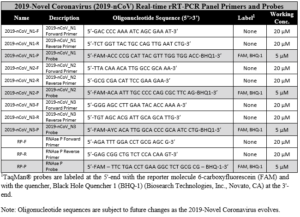By Marylou Gibson, Ph.D.
Background on 2019 Novel Coronavirus
The 2019 Novel Coronavirus (2019-nCoV) continues to spread within China (as of this posting date). Cases are spreading beyond Hubei province, and thousands of infected people have been reported in more than 20 regions across China. Twenty-three countries around the globe have also reported cases. This is a rapidly changing and serious situation. With an incubation period of 2-14 days, we seem to likely be in the early-to-mid stage of this outbreak. Containment and health protection is paramount to limit the severity and spread of 2019-nCoV. China has enacted an unprecedented quarantine of potential infected locales in order to protect the global community.
Microbiologics, Inc. stands united with all the microbiologists, epidemiologists, and medical personnel working to contain this outbreak, as well as the scientists who will work to develop accurate diagnostics and vaccines to protect against future risks. We want to help you stay informed and offer you diagnostic and testing solutions for your laboratory when you need them. You can see some of the products and services that we offer to assist your Coronavirus research at the end of this blog post. Please read on for more information and resources on the current outbreak.
Resources for 2019 Novel Coronavirus
Who will perform virus diagnostic testing?
Microbiologists want to know how and when they may be required to perform Coronavirus specific testing. So far it is not clear if or when general testing will become widespread. As of this posting date, within the United States, diagnostic testing for 2019nCoV can be conducted only at the CDC. Diagnostic laboratories are NOT to attempt viral isolation: this work is presently limited to a BSL3 facility.
What should I do if I may have a patient infected with 2019 Novel Coronavirus?
The CDC’s Emergency Operations Center will assist the local health departments to collect, store, and ship specimens from a patient under investigation directly to the CDC. The local lab may have already tested that specimen for other respiratory pathogens, however. For general guidelines for collecting, handling, and testing clinical specimens, please review the CDC’s guidelines. For regions outside the United States, review the WHO guidelines for emergency preparedness.
What is the risk to laboratory personnel?
Laboratorians and health care workers also need to understand their risk of infection while working with potentially positive samples. Since this is an evolving outbreak, it is prudent to take a cautious approach and discuss procedures with your safety officer. The CDC offers detailed guidelines for collecting and handling specimens that may contain 2019-nCoV. You should practice good microbial techniques, avoid aerosolization, and wear personal protective equipment including eye protection, among other critical precautions that may change as more information becomes available.
Information Provided by the World Health Organization
The World Health Organization (WHO) is currently leading the effort to control the spread of disease, share information, and coordinate the community engagement response. The WHO’s website offers information and guidance for this rapidly changing situation that is useful for scientists and lay persons alike.
The WHO updates a daily “Situation report” for the 2019-nCoV, tracking the number of cases and deaths, while attempting to dispel myths and rumors. The rapid spread tracked in these situation reports is alarming.
Assays for 2019-nCoV Under Development
Several assays that detect the 2019-nCoV have been developed, with more in current development, both at WHO and CDC labs and commercially. Some assays may detect only the novel virus, and some may also detect other strains (e.g. SARS-CoV) that are genetically similar.
The WHO provides technical and specifically laboratory guidance for testing in humans. There are other links at this location describing PCR and sequencing protocols from China, Germany, Hong Kong, Thailand, and Japan.
The WHO published the following data regarding Panel Primers and Probes from the CDC. These sets of Real Time PCR primers and probes are presented with a series of disclaimers from the CDC. Please read the disclaimers thoroughly before using the information. These primer and probe sets are designed for the universal detection of SARS-like coronaviruses and 2019-nCoV.
2019-Novel Coronavirus (2019-nCoV) Real-time rRT-PCR Panel Primers and Probes
Dept Health and Human Services, CDC, Division of Viral Diseases
The CDC also provides instructions for an RT PCR assay for in vitro detection of 2019-nCoV in respiratory samples.
Coronavirus Tools from Microbiologics
Microbiologics has both live and inactivated whole viruses available for two different human coronaviruses – 229E and OC43, which are distant relatives of the 2019 nCoV and minimally homologous. These viruses, while not 100% homologous to 2019-nCoV or SARS CoV, contain the entire RNA virus genome and may be useful for your assay development purposes. They are among the four coronaviruses that are associated with the human common cold. The two other human cold viruses, HKU and NL66, are available as subgenomic DNA clones from Microbiologics. We are currently preparing RNA transcripts of the 2019n-CoV which should be paired with the CDC recommended primer probe sequence cited above. Please contact us to request more information and to be put on our interest list.
Microbiologics staff at our Virapur subsidiary include four virologists who can design, build, and perform antiviral assays to test virus susceptibility against coronavirus 229E or OC43. Our skills also enable us to pseudotype VLPs with 2019n-CoV spike protein for binding inhibition studies.
Contact us to learn more
Marylou Gibson, Ph.D.
mgibson@virapur.com
Josh Pulido
jpulido@virapur.com
Please note: the information and links in this post are subject to rapid change. Some external content from the WHO and CDC linked above may disappear or change as new findings emerge.







0 Comments